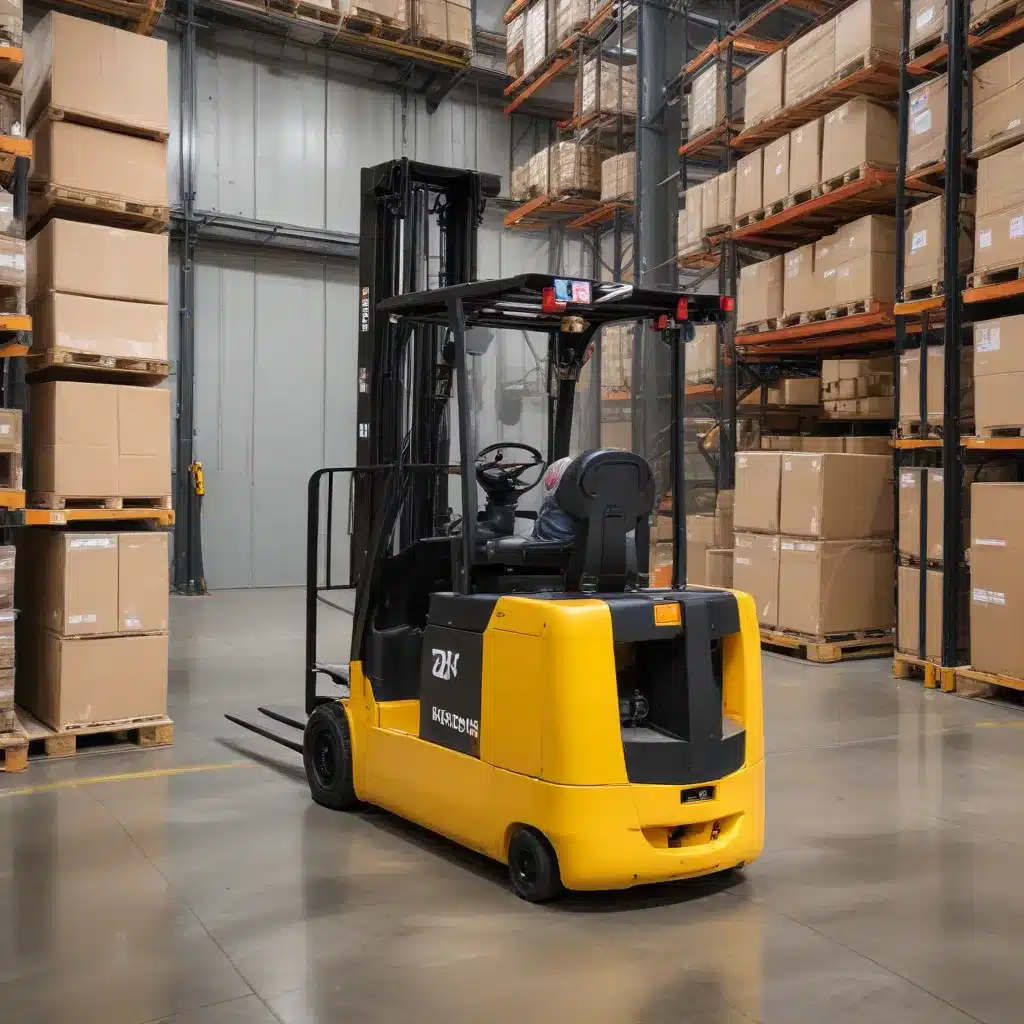
Navigating the Hazards of Forklift Operations
Forklift operations are the backbone of countless industrial and warehousing environments, enabling the efficient movement and storage of materials. However, these powerful machines also pose significant safety risks, with an estimated 100,000 forklift-related accidents occurring annually, resulting in 35,000 serious injuries. The average cost per collision can reach a staggering $180,000, underscoring the critical need to prioritize safety within forklift-centric workspaces.
Recognizing this imperative, seasoned industry experts have pioneered innovative forklift collision avoidance systems that leverage cutting-edge technologies to enhance operator and pedestrian safety. These advanced systems leverage a combination of AI, sensor fusion, and real-time location tracking to create a comprehensive safety net, empowering businesses to achieve their “Zero Accident” goals.
Integrated Collision Avoidance: Protecting Operators and Pedestrians
Forklift collision avoidance systems are designed to address the unique safety challenges posed by the dynamic and often congested environments in which forklifts operate. These integrated solutions combine multiple technologies to create a robust safety ecosystem, safeguarding both forklift operators and pedestrians.
Pedestrian Detection and Alerting
At the core of these systems is the ability to detect the presence of pedestrians in the vicinity of forklifts. Utilizing advanced sensors and AI-powered computer vision, these solutions can accurately identify the location of people within the forklift’s operating range, providing both audible and visual alerts to the operator.
This early warning system not only heightens the operator’s awareness but also triggers an automatic speed reduction, ensuring a safe operating speed in the presence of pedestrians. Complementing this, the system can also provide vibration alerts to pedestrians, further enhancing their situational awareness and ability to react promptly.
Forklift-to-Forklift Collision Avoidance
Collisions between forklifts pose another significant risk, particularly in crowded warehouses and distribution centers. Forklift collision avoidance systems leverage high-precision ultra-wideband (UWB) technology to detect the presence of nearby forklift trucks, triggering immediate speed adjustments and audio-visual alerts to the operators.
By creating a real-time awareness of neighboring forklifts, these systems empower operators to make informed decisions, resulting in a safer work environment and a reduction in the likelihood of costly collisions.
Integrated AGV and AMR Safety
As automation continues to transform material handling operations, the coexistence of forklifts, Automated Guided Vehicles (AGVs), and Autonomous Mobile Robots (AMRs) introduces additional complexities. Forklift collision avoidance systems address this challenge by implementing a two-stage speed limitation system, which automatically reduces the forklift’s speed when in close proximity to AGVs or AMRs.
This intelligent integration ensures that forklifts and autonomous vehicles can operate safely in shared spaces, minimizing the risk of collisions and fostering a harmonious and efficient workflow.
Zone-Based Speed Control: Enhancing Safety in High-Risk Areas
Recognizing that certain areas within a facility pose a greater risk of accidents, forklift collision avoidance systems incorporate a zone-based speed control feature. By leveraging fixed anchors and configurable ranging zones, the system can dynamically adjust the forklift’s maximum speed to match the unique safety requirements of each designated area.
This adaptive approach is particularly beneficial in high-risk zones, such as narrow corridors, intersections, doorways, and areas with a high density of pedestrian traffic. By enforcing reduced speeds in these critical zones, the system cultivates a culture of workplace safety and accident prevention.
Comprehensive Forklift Fleet Management
Forklift collision avoidance systems do not operate in isolation; they integrate seamlessly with advanced fleet management solutions to offer a holistic approach to forklift operations. These integrated platforms leverage cloud-based technologies to provide valuable insights and real-time alerts, empowering businesses to make data-driven decisions that prioritize safety and operational efficiency.
Through comprehensive data analytics and reporting, fleet managers can identify risky behaviors, assess safety performance, and implement targeted training or intervention measures to address any concerns. By fostering a proactive safety culture, these solutions contribute to a significant reduction in near-miss incidents and a substantial improvement in overall workplace safety.
Compliance and Industry Leadership
Forklift collision avoidance systems are designed to not only enhance safety but also ensure compliance with industry-standard regulations, such as those set forth by the Occupational Safety and Health Administration (OSHA). By meeting and exceeding these safety guidelines, businesses can demonstrate their commitment to worker well-being while mitigating the risk of costly fines and legal liabilities.
Moreover, these innovative solutions have garnered industry recognition, with leading providers like Trio Mobil being featured in prestigious industry reports and named as visionaries in the field. This accolade underscores the transformative impact these technologies have had on forklift safety and the broader material handling industry.
Empowering a Safer Future
As the material handling landscape continues to evolve, the need for comprehensive forklift collision avoidance systems has become increasingly paramount. By leveraging the latest advancements in AI, sensor technology, and real-time location tracking, these solutions are redefining the standards of workplace safety, contributing to a future where forklift operations are seamlessly integrated with robust safety measures.
Through the implementation of these innovative systems, businesses can not only protect their employees and assets but also enhance their overall operational efficiency, compliance, and industry reputation. As the industry continues to prioritize safety, the adoption of forklift collision avoidance technologies will undoubtedly play a pivotal role in shaping a safer and more productive material handling landscape.
Conclusion
Forklift operations are essential to the success of countless industries, but they also carry inherent risks that must be addressed. Forklift collision avoidance systems offer a comprehensive solution, harnessing the power of cutting-edge technologies to enhance operator and pedestrian safety, minimize accidents, and drive operational excellence.
By investing in these advanced systems, businesses can create a culture of workplace safety, ensure compliance with industry regulations, and position themselves as leaders in the material handling industry. As the demand for safer and more efficient forklift operations continues to grow, the adoption of forklift collision avoidance systems will undoubtedly be a critical component of the industry’s future.
To learn more about the latest innovations in forklift safety and fleet management, visit Forklift Reviews – your trusted source for expert insights and practical guidance.

